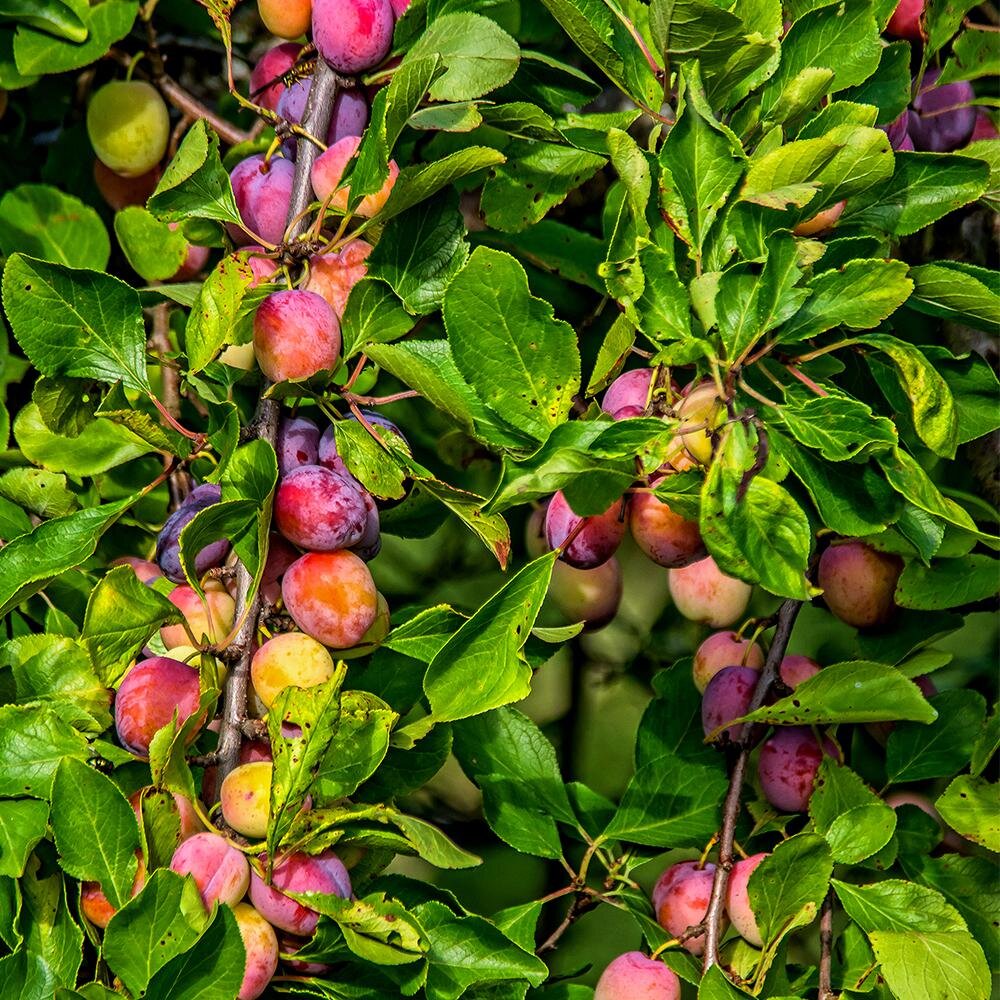Welcome to my Food Forest where I grow an number of fruits in the Bee Better Teaching Garden. Information in this fruit series is based on knowledge I’ve gained growing in hardiness zone 7b, in Raleigh, North Carolina. Helen Yoest
Kind:
Latin Name: Prunus salicina ‘Santa Rosa’
Common Name: ‘Santa Rosa’ Plum
Type: Deciduous tree
Height: 18 to 10 feet
Spread: 18 to 20 feet
Pollination: While the Santa Rosa plum is a self-pollinator, you'll harvest a better crop when planted with other Japanese varieties. We only have one tree, and we get enough fruit! Not enough to share, but enough for our family.
Fruit Health Benefits: The fruit is stomachic, meaning it promotes the appetite or assisting digestion.. It is said to be good for allaying thirst and is given in the treatment of arthritis.
Although no specific mention has been seen for this species, all members of the genus contain amygdalin and prunasin, substances which break down in water to form hydrocyanic acid (cyanide or prussic acid.) In small amounts, this exceedingly poisonous compound stimulates respiration, improves digestion and gives a sense of well-being.
Wildlife Benefits: Honey bee and a few native bees.
Origin of species: Japan
Cultivars: We grow ‘Santa Rosa’
Originating in the central states, cultivars of the American plum include "Hawkeye," "Blackhawk," "De Soto," "Fairlane," "Alderman," "Weaver," "Stoddard," "Tecumseh," "Toka" and "Waneta."
Cultivated American plums are grown for ornamental purposes and fruit production. Introduction of cultivars into the eastern and western states makes it possible for plum growers to reap the benefits of the characteristics of the American plum.
The Japanese plum cultivar ‘Santa Rosa’ cross-pollinated with American plum or one of its cultivars performs well in a Mediterranean climate, requiring very little winter cold to bloom and set fruit.
Culture Information:
Sun: Full Sun
Water: Medium to Moist
Zone: 5 to 8
Years to bear fruit: 4 to 6 years
Harvest Time: July
Care:
Plant: A "Santa Rosa" plum tree needs to be planted in well-drained soil and receive full sun to do its best. If the location has too much shade, the tree will produce fewer and lower quality fruit. You want full sun for at least 6 hours a day in late spring, in summer and in early fall.
The ‘Santa Rosea’ plum tree also requires 500 chill hours.
Fertilizer/pH: 4.5 to 7.5. In sandy, fast draining soil, you’ll likely need to fertilize. Young trees should be fertilized with a nitrogen fertilizer three times, in March, May, and July. Mature trees should be fertilized with a fertilizer intended for fruit trees, according to the package directions. Apply the entire amount in the spring. Irrigate immediately after fertilizing, and if it is very dry, also irrigate a day before.
In our home garden, where I’ve been nurturing since 1998, the clay has been broken up from years of adding 4 inches of composted leaf mulch from the City of Raleigh. We don’t tend to need fertilizer anywhere in there garden. It’s all about the soil!
Mulch: Heavily mulch around the base of the tree with an organic mulch such as leaf mulch, pine straw, or other barks.
Groom/Prune: Plum trees need to be pruned to encourage fruiting, develop an appropriate shape and control excess growth. Generally, prune when the leaves are off (when the tree is dormant). It’s easier to see what you are doing and removal of dormant buds (growing points) invigorates the remaining buds. Santa Rosa plums are likely to also need summer pruning to control size and vegetative growth.
There are several approaches to pruning – these directions are for the open-center vase shape frequently used for apricot trees. Right after planting the bare root tree, cut it off to one short stick 24 to 30 inches high (1/4 inch above a bud or branch) and cut any other side shoots remaining below that. This encourages low branching and equalizes the top and root system.
If the tree is growing vigorously, in the late spring of the first growing season, select three or four shoots to become your primary scaffold. (If the tree isn’t vigorous enough, delay this until August.) To the extent possible, these scaffold branches should be spaced evenly around the tree and each about 6 inches apart from the next vertically, with the lowest 12 to 18 inches above the ground. Look to keep branches at an angle of around 45 degrees to the trunk if possible. Don’t choose branches directly vertically on top of one another. Pinch back all of the other shoots to about 4 to 6 inches. Young plum trees have vigorous upright growth, so you will need to prune its vigorous vertical shoots back to their outward-facing buds/branches and trim away branches that form narrow, V-shaped forks to avoid limb breakage. By the end of the fourth year, you’d like to end up with three to four primary scaffolds and five to seven secondary scaffold branches.
Other pruning tips:
• Summer pruning is likely to be needed to remove upright center growth to open up the tree and get sunlight into the center.
• Angle cuts at about 45 degrees away from the nearby bud or stem.
• If a branch isn’t where you want it, you may be able to tie it down or spread it to get it into a better place rather than cutting it off.
• When pruning a mature plum tree, remove about 20% of the prior year’s growth, starting with weak, diseased or dead limbs; any limbs pointing downward; watersprouts and any sprouting below the grafting junction.
Pest/disease Control: Susceptible to plum leaf scald and other bacterial diseases. Additional diseases and insects can affect plum trees as well, including scales, borers, mites, aphids, leaf spots and rots.
Propagation: Mix 1 portion of rooting hormone liquid concentrate with 9 parts water. dip the severed end into the rooting solution for five seconds.. Check the plum cutting for root growth in four to six weeks.
Comments:
Delicious!

